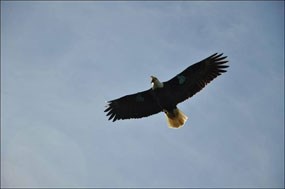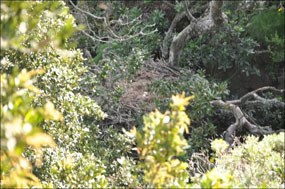
Cedrick Villasenor . 
Cedrick Villasenor .
You are viewing ARCHIVED content published online before January 20, 2025.
Please note that this content is NOT UPDATED, and links may not work. For current information,
visit https://www.nps.gov/aboutus/news/index.htm.
Contact: Yvonne Menard, 805-658-5725
For the past few months biologists have been following the Pelican Harbor bald eagle pair after they abandoned their nest, entertained other nest sites, and finally settled into a more remote location on Santa Cruz Island. This is the same pair that naturally hatched the first bald eagle chick in over 50 years on the Channel Islands in 2006. Biologists were interested in seeing where they settled so they could monitor their breeding success and install a webcam that is followed by thousands of dedicated eagle fans and provides vital data for the recovery program. The birds, known as K10 and K26, appeared to move into a nest in a toyon tree above Potato Harbor-only to later leave and stake territory in a nest on a steep cliff overlooking Twin Harbors. The birds' fickle behavior caused the partner organizations managing the webcam to scramble to set up a relay site for a webcam at Potato Harbor. When it became evident that the birds flew this coop, they were tracked to Twin Harbors-a site too remote to be connected via webcam. With five pairs of bald eagles nesting on Santa Cruz Island this year, an alternate site for the webcam was set up last week to monitor a different bald eagle pair at a nest in Sauces Canyon just in time for viewers to watch one chick hatch. In 2010 the bald eagle webcam connected over 160,000 unique visitors from over 145 countries worldwide who generated over 1.5 million hits. These viewers daily keep watch over the birds and contribute to the biologists' monitoring efforts.
Testing Technology Technologically, the Sauces Canyon nest webcam is inherently challenging because the signal must travel 45 miles from the remote, rugged, and distant location. On the island, the nest camera sends a video signal over a distance of fifteen miles via three separate relays, each with its own mini solar power system. The Institute for Wildlife Studies manages this transmission. The signal then connects to the Channel Islands Live microwave system, hosted by the National Park Service and Ventura County Office of Education (VCOE), before it travels nearly 30 miles across the ocean to the mainland. In Ventura County the signal relays through two mountaintop communication towers to VCOE headquarters in Camarillo. At VCOE, technicians encode the video signal for publishing to the Internet so viewers can daily watch the chicks grow and develop. The Bald Eagle Webcam and associated discussion board can be found at: https://www.nps.gov/chis/photosmultimedia/bald-eagle-webcam.htm To participate in a bald eagle blog:
Prior to 2006, the last known successful nesting of a bald eagle pair on the northern Channel Islands was in 1950 on Santa Rosa Island. Bald eagles disappeared from the Channel Islands by the early 1960s, due to human impacts, primarily DDT and PCB contamination. The effects of these chemicals are magnified in the food chain, causing bald eagles to lay thin-shelled eggs that either dehydrate or break in the nest.
Bald eagle restoration efforts on the Channel Islands are funded by the Montrose Settlements Restoration Program (MSRP), a multi-agency program funded by court settlements and dedicated to restoring natural resources harmed by DDTs and PCBs released into the environment by Montrose Chemical Corporation and other industrial sources in southern California in the mid 20th century. Further information on MSRP can be found at: www.montroserestoration.gov. The National Park Service and The Nature Conservancy, co-owners of Santa Cruz Island, continue to partner to protect and restore the island ecosystem. The Pelican Harbor nest is on The Nature Conservancy property. For more information visit: www.nature.org/eagles. The Institute for Wildlife Studies, a non-profit organization dedicated to the conservation of wildlife species, has conducted bald eagle restoration on the Channel Islands for over 25 years, including efforts on the northern islands within Channel Islands National Park. For links to webcams on Catalina Island visit: www.iws.org.
|
Last updated: February 27, 2015
